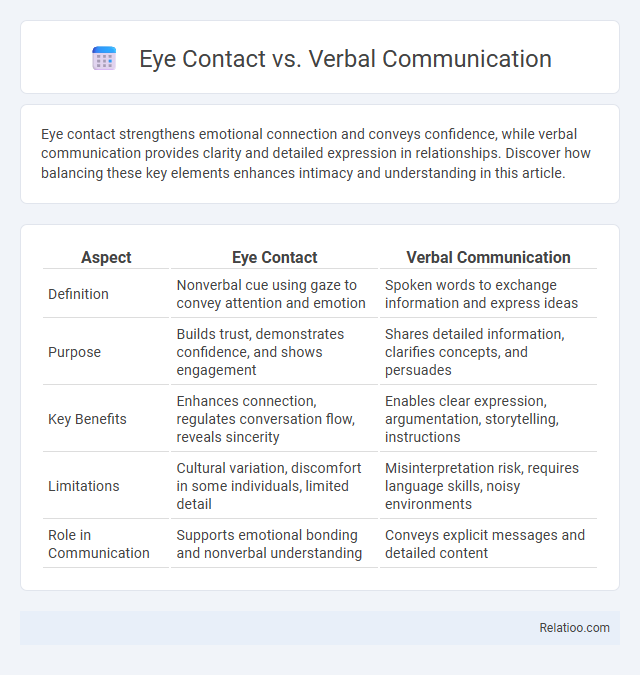Eye contact strengthens emotional connection and conveys confidence, while verbal communication provides clarity and detailed expression in relationships. Discover how balancing these key elements enhances intimacy and understanding in this article.
Table of Comparison
| Aspect | Eye Contact | Verbal Communication |
|---|---|---|
| Definition | Nonverbal cue using gaze to convey attention and emotion | Spoken words to exchange information and express ideas |
| Purpose | Builds trust, demonstrates confidence, and shows engagement | Shares detailed information, clarifies concepts, and persuades |
| Key Benefits | Enhances connection, regulates conversation flow, reveals sincerity | Enables clear expression, argumentation, storytelling, instructions |
| Limitations | Cultural variation, discomfort in some individuals, limited detail | Misinterpretation risk, requires language skills, noisy environments |
| Role in Communication | Supports emotional bonding and nonverbal understanding | Conveys explicit messages and detailed content |
Understanding Eye Contact in Communication
Eye contact serves as a powerful nonverbal cue that enhances trust, conveys attentiveness, and regulates conversational flow, distinguishing it from verbal communication that relies on spoken words and language structure. Effective eye contact strengthens emotional connection and provides feedback beyond the literal meaning of speech, supporting deeper understanding and engagement in interactions. Mastering the balance between eye contact and verbal communication optimizes clarity, empathy, and social influence during interpersonal exchanges.
The Role of Verbal Cues in Conversations
Verbal cues play a crucial role in conversations by providing clarity, context, and emotional nuance that eye contact alone cannot convey. Words, tone, and pacing enhance understanding, allowing speakers to express detailed ideas and intentions effectively. While eye contact supports engagement and trust, verbal communication drives the message, ensuring precise and meaningful interaction.
Nonverbal vs. Verbal Communication: Key Differences
Eye contact plays a crucial role in nonverbal communication by conveying emotions, attention, and confidence without spoken words, while verbal communication relies on language and speech to express ideas and information. Nonverbal cues such as eye contact, facial expressions, and body language complement verbal messages and enhance understanding during interactions. Effective communication requires integrating both eye contact and spoken words to ensure clarity, build rapport, and interpret intentions accurately.
Psychological Impact of Eye Contact
Eye contact profoundly influences psychological dynamics by establishing trust, enhancing emotional connection, and conveying confidence in communication. Verbal communication transmits explicit information while eye contact delivers nonverbal cues that regulate interactions and signal attentiveness or sincerity. Your ability to maintain appropriate eye contact can significantly improve interpersonal relationships and boost mutual understanding beyond spoken words.
Cultural Variations in Eye Contact and Speech
Eye contact significantly varies across cultures, influencing the interpretation of verbal communication during interactions. In Western societies, direct eye contact often signals confidence and honesty, whereas in many Asian and Indigenous cultures, prolonged eye contact may be perceived as disrespectful or confrontational, affecting speech patterns and message delivery. Understanding these cultural nuances in eye contact and verbal communication enhances cross-cultural competence and reduces miscommunication in global contexts.
Trust and Credibility: Eye Contact or Words?
Eye contact significantly enhances trust and credibility by conveying confidence, sincerity, and attentiveness, often making nonverbal cues more impactful than words alone. Verbal communication provides explicit information, but without consistent eye contact, messages may seem less genuine or persuasive. Combining eye contact with clear verbal messages creates a powerful synergy that solidifies trust and establishes stronger credibility.
When Eye Contact Trumps Verbal Messages
Eye contact conveys trust, confidence, and emotional intensity, often outweighing verbal communication when words are ambiguous or insufficient. Your nonverbal cues, especially sustained eye contact, enhance message clarity, build rapport, and signal genuine interest more effectively than spoken language alone. In high-stakes conversations, prioritizing eye contact can reveal sincerity and strengthen connections beyond what verbal messages achieve.
Limitations of Relying Solely on Words
Relying solely on verbal communication overlooks the critical role of eye contact in conveying emotions and intentions, often resulting in misunderstandings and reduced trust. Eye contact provides nonverbal cues like sincerity and engagement, which words alone cannot fully express. Without integrating eye contact, verbal messages may lack depth, leading to impaired interpersonal connections in both personal and professional settings.
Balancing Eye Contact and Verbal Communication
Balancing eye contact and verbal communication enhances your ability to convey confidence and sincerity while maintaining engagement. Consistent eye contact establishes trust and connection, whereas clear verbal messages provide context and clarity. Striking the right balance ensures your audience feels both understood and valued, improving overall communication effectiveness.
Enhancing Communication Skills: Practical Strategies
Effective communication skills improve significantly when balancing eye contact with verbal communication, fostering trust and engagement in conversations. Maintaining steady eye contact enables clearer interpretation of emotions and intentions, while verbal communication conveys detailed information and context. Practicing active listening, using appropriate gaze duration, and matching verbal tone with nonverbal cues enhances interpersonal connections and message clarity.

Infographic: Eye contact vs Verbal communication
 relatioo.com
relatioo.com